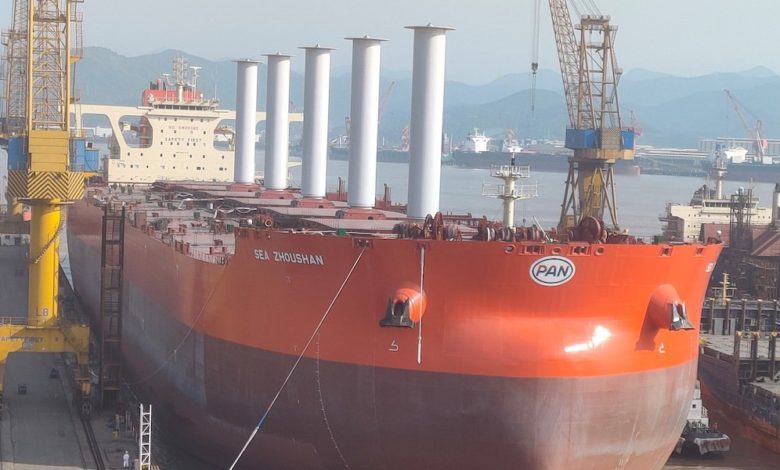White paper shows dry bulk’s path to zero emissions

Independent nonprofit organisation the International Council on Clean Transportation (ICCT) has published a white paper in which it shows how three existing bulk carriers of different sizes operating in different regions around the world could become zero-emission vessels (ZEVs).
Previous ICCT research has demonstrated both the potential for liquid hydrogen (LH2) fuel cells to replace fossil fuels for containerships on the transpacific corridor and the energy-saving and emissions-reduction potential of rotor sails. These two technologies could be combined to create ZEVs, with bulk carriers particularly well suited according to the ICCT because they are more likely to have enough space onboard for the fuel cell and hydrogen fuel storage systems and enough deck space for installing or retrofitting rotor sails.
Wind-assisted propulsion can be paired with liquid hydrogen fuel cells resulting in ships that generate no direct pollution
The white paper considered whether LH2 fuel cells or compressed hydrogen (CH2) fuel cells could replace fossil fuels for bulk carriers by investigating three ships of varying sizes: a 57,000 dwt dry bulk carrier transiting the Chinese coast; a 69,000 dwt ore and coal carrier sailing the North American Great Lakes; and a 7,570 dwt cement carrier operating in Europe’s North and Baltic Seas. The authors used 2019 Automatic Identification System (AIS) ship traffic data and weather data observations to estimate the ships’ total energy use and the energy-saving potential of rotor sails for two routes for each ship. Results show the two larger ships could complete both of their modelled routes using LH2, even without the help of wind-assisted propulsion. The smallest bulk carrier does not have as much space available for LH2, and that makes it relatively more challenging for this ship. Still, results show additional legs could be achieved for the smallest ship by using rotor sails in combination with LH2, and for the two longest legs, by replacing 2.4% of its cargo space with LH2 in combination with four rotor sails.
For the rotor sails, results show a range of port-to-port energy savings of 0.1% to 7.2% per rotor. Larger ships had lower relative savings compared to smaller ships because the power generated by the rotor is smaller relative to the power used by the engines. As a proportion of total energy use, rotor sails had the greatest energy-saving potential for the European bulk carrier and were capable of port-to-port energy savings up to 7.2% per rotor. With four rotor sails, energy savings of up to 28% or more are theoretically possible.
“Wind-assist technology can be used to both increase fuel savings and extend the range of all ships, including those powered by hydrogen fuel cells,” the ICCT suggested. This was the case for the Chinese bulk carrier and for some of the legs of the European bulk carrier, which were able to attain previously unattained voyages using fuel cells with the addition of rotor sails. While wind-assisted propulsion helped the European bulk carrier achieve some unattained legs, several remained unattained, meaning that a portion of the ship’s cargo space would need to be replaced with additional hydrogen fuel. Even in these instances, wind-assisted propulsion provided a benefit. The research shows that four rotor sails would cut the amount of cargo space that needed to be replaced with hydrogen fuel from 3% or 4.5% to just 2.4%.
This research also produced some insights into the factors that affect energy savings from rotor sails. The ICCT found that energy savings vary depending on wind conditions and are sensitive to wind speed and wind direction. Winter voyages tended to have higher energy-saving potentials than other times of year due to higher wind speeds. Apparent wind directions across the side of the ship and slightly toward the bow produce the greatest energy savings. Energy savings are also sensitive to the spin ratio, with optimal savings at spin ratios of between three and four. The size of the rotor sails also impacts performance. All else equal, taller rotors result in greater energy savings.
The study claims that wind-assisted propulsion can be paired with liquid hydrogen fuel cells resulting in ships that generate no direct pollution. However, the hydrogen would need to be sourced from renewable energy and not fossil fuels to have climate benefits.
“Knowing that rotor sails can reduce energy use and emissions for new and existing ships could give governments the confidence to raise the ambition of climate policies,” the authors suggested.

Interesting, but do the fuel cells get installed as a retro-fit?? Or only in newbuildings?